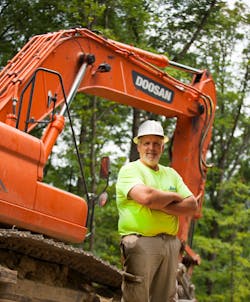Like many contractors, John Anderson, president of John Anderson Construction of Warren, PA, has seen tough times—the 2008 recession, for example. He remembers a time when he and his office manager were cashing out credit cards to make payroll. “I asked her how much longer we could keep going and she said, ‘I don't know, we made it another week.’ We’d ask customers when they were going to cut a check for us,” he says. “They’d say it was going in the mail. She’d say ‘Just hold it, we'll drive two hours to Buffalo to pick it up so that we can make payroll.’ Anderson doesn’t believe in rejecting an opportunity until he knows what it may present. “We’ve always been more into saying yes and then figuring it out.” Indeed, opportunities have come to John Anderson Construction in the last decade by way of increasing US energy production for which Anderson’s company does excavation work for underground natural gas pipelines in the Marcellus Shale. Anderson’s 90 employees provide services in earthwork, concrete, pipeline, and facilities with a fleet of 32 excavators, 15 bulldozers, 12 skid-steers, six lifts, and 40 pickup trucks. He’s favored Doosan ever since he bought his first in 2001 and strives for uniformity in the fleet.
What He Does Day to Day
Anderson favors being in the field and collaborating with supervisors on projects. “I have my own job that I run and most of the day, especially if it's a pipeline, I sit in that excavator,” he says. “I like working with the young guys who want to learn. You hear all of the time that young people don't want to work. That's not true. There's a lot of good people who want to work. Some of them develop in a year. Some might take two or three years. It’s not the young people's responsibility to conform to the older generations' ways. It's our job to figure out how to get the most out of them. Once you accept that, it makes it easier.” Anderson uses informal job titles to promote the idea of teamwork and eschews the title "laborer." “What does that mean anyway? These are the most important guys on the job—the ones getting dirty, working hard every day,” he says. “If you can give these young guys an opportunity to jump on the machine even for a few minutes, they don't feel like they're just the low guy on the totem pole. It keeps them interested and focused.”
What Led Him Into This Line of Work
Anderson worked as a securities advisor after his 1984 college graduation. He was building a house and worked for the contractor who did his basement. He was subsequently hooked on construction work and five years later began doing basement and garage floors and sidewalks. He evolved from a concrete contractor to a site contractor to an excavating contractor.
What He Likes Best About His Work
“I’ve worked with a ton of good people over the years and I've had a ton of good people working for me,” says Anderson. “At this point, I probably don't have to do this every day if I don't want to. But I have a ton of loyalty for the people working for me. I am proud of what we've been able to accomplish.”
His Greatest Challenge
Anderson says his biggest challenge is to try to keep everybody pulling the rope in the same direction. “I tell people in a leadership role that treating everybody equally doesn't mean treating everybody the same,” he says. “Some people need to push. Some need to pull. Some people need a hug. Some people need a kick in the (rear). It’s our job to figure out what that is, to keep them engaged and focused on what they're doing so they can grow.” His company has a high retention rate; many stay up to 20 years. Anderson gives them opportunities, benefits, and appreciation. “They feel like we are in this together. I preach that every one of us—myself included—is more valuable as part of this team than we are individually and we’re all working for the same goals.”



